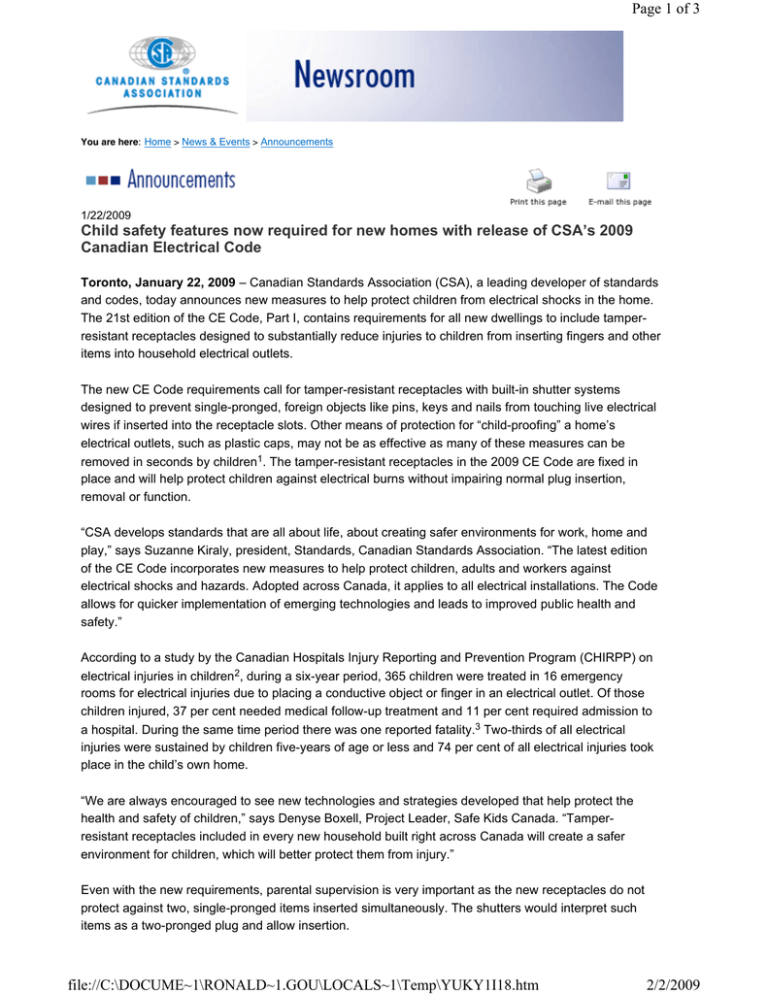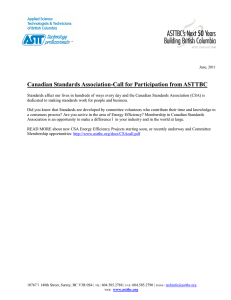
Page 1 of 3
You are here: Home > News & Events > Announcements
1/22/2009
Child safety features now required for new homes with release of CSA’s 2009
Canadian Electrical Code
Toronto, January 22, 2009 – Canadian Standards Association (CSA), a leading developer of standards
and codes, today announces new measures to help protect children from electrical shocks in the home.
The 21st edition of the CE Code, Part I, contains requirements for all new dwellings to include tamperresistant receptacles designed to substantially reduce injuries to children from inserting fingers and other
items into household electrical outlets.
The new CE Code requirements call for tamper-resistant receptacles with built-in shutter systems
designed to prevent single-pronged, foreign objects like pins, keys and nails from touching live electrical
wires if inserted into the receptacle slots. Other means of protection for “child-proofing” a home’s
electrical outlets, such as plastic caps, may not be as effective as many of these measures can be
removed in seconds by children1. The tamper-resistant receptacles in the 2009 CE Code are fixed in
place and will help protect children against electrical burns without impairing normal plug insertion,
removal or function.
“CSA develops standards that are all about life, about creating safer environments for work, home and
play,” says Suzanne Kiraly, president, Standards, Canadian Standards Association. “The latest edition
of the CE Code incorporates new measures to help protect children, adults and workers against
electrical shocks and hazards. Adopted across Canada, it applies to all electrical installations. The Code
allows for quicker implementation of emerging technologies and leads to improved public health and
safety.”
According to a study by the Canadian Hospitals Injury Reporting and Prevention Program (CHIRPP) on
electrical injuries in children2, during a six-year period, 365 children were treated in 16 emergency
rooms for electrical injuries due to placing a conductive object or finger in an electrical outlet. Of those
children injured, 37 per cent needed medical follow-up treatment and 11 per cent required admission to
a hospital. During the same time period there was one reported fatality.3 Two-thirds of all electrical
injuries were sustained by children five-years of age or less and 74 per cent of all electrical injuries took
place in the child’s own home.
“We are always encouraged to see new technologies and strategies developed that help protect the
health and safety of children,” says Denyse Boxell, Project Leader, Safe Kids Canada. “Tamperresistant receptacles included in every new household built right across Canada will create a safer
environment for children, which will better protect them from injury.”
Even with the new requirements, parental supervision is very important as the new receptacles do not
protect against two, single-pronged items inserted simultaneously. The shutters would interpret such
items as a two-pronged plug and allow insertion.
file://C:\DOCUME~1\RONALD~1.GOU\LOCALS~1\Temp\YUKY1I18.htm
2/2/2009
Page 2 of 3
New this year, the CE Code, Part I, is now based on a three-year production cycle rather than a fouryear cycle. The shortened update period allows changes in technology and the introduction of safety
requirements more quickly, and enables the code to be in closer alignment with the U.S. National
Electrical Code. Meeting this new shortened deadline required the dedication and commitment of more
than 250 committee members and 33 staff as well as stakeholder contributions from the United States,
Mexico and the Bahamas. The 2009 CE Code will be referenced in safety legislation in all Canadian
jurisdictions as well as in the Bahamas.
Developed by industry and government stakeholders, the Canadian Electrical Code, Part I, serves as
the basis for mandatory wiring regulations across Canada. It will be up to Provincial or Territorial
regulators to review and adopt the 2009 CE Code into legislation by reference, together with any
amendments needed to address regional conditions, and determine when the code will be effective in
each province or territory.
About the C22.1-2009 Canadian Electrical Code, Part I
Since 1927, CSA’s Canadian Electrical Code, Part I, has provided the basis for the installation and
maintenance of electrical equipment in Canada. Regularly updated to address changing technology and
safety requirements, the Canadian Electrical Code series consists of three parts: Part I - installation;
Part II - standards for the construction, testing and making of electrical equipment; and Part III outside
wiring.
The 2009 Canadian Electrical Code, Part I, includes numerous updates, including:
z requirements for electrically connected carbon monoxide alarms;
z recognition of new technologies such as under-carpet wires and cables;
z new specifications for receptacle locations for combination microwave oven / range hoods;
z new bonding requirements for swimming pools;
z electrical safety requirements for ski-lift, tow rope, and similar installations; and
z new requirements for hazardous locations, emergency power supply systems, and motor
overload devices.
The 2009 Canadian Electrical Code will be priced at $150 CAD. It is available online at
www.shopcsa.ca, by calling CSA Standards Sales at 800-463-6727, or by e-mail at sales@csa.ca. The
code is available in print, PDF and the new Mobile Device Format (MDF). To help industry understand
and apply the code, CSA’s Learning Centre is offering numerous training programs and seminars.
Information on training is available at https://learningcentre.csa.ca/
For the first time ever, by the end of January 2009, the CE Code will be sold through a major Canadian
retailer as Mark’s Work Wearhouse begins offering the code for sale at point-of-purchase displays
across Canada.
1 1997, Biokinetics Lab at Temple University in Philadelphia Study of 4 different receptacle caps
2 1997, Electrical Injuries to Children less than 20 years of age, Canadian Hospitals Injury Reporting and Prevention Program (CHIRPP)
3 Epidemiology of electrical and lightning related deaths and injuries among Canadian children and youth. Inj. Prev., Apr 2004; 10: 122 124. http://injuryprevention.bmj.com/
About CSA
Canadian Standards Association (CSA) is a membership association serving industry, government,
consumers and other interested parties in Canada and the global marketplace. As a leading solutionsbased standards organization providing standards and codes development, application products,
training and advisory services, CSA aims to enhance public safety, improve quality of life, preserve the
file://C:\DOCUME~1\RONALD~1.GOU\LOCALS~1\Temp\YUKY1I18.htm
2/2/2009
Page 3 of 3
environment and facilitate trade. The Canadian Standards Association is a division of CSA Group, which
also consists of CSA International, which provides testing and certification services for electrical,
mechanical, plumbing, gas and a variety of other products; and OnSpeX, a provider of consumer
product evaluation, inspection and advisory services for retailers and manufacturers. For more
information visit www.csa.ca.
Version française disponible
Contact: Anthony Toderian
Senior Media Relations Officer
CSA Group
T: 416-747-2620
E: anthony.toderian@csagroup.org
Articles & Speeches | Archives | Search
Standards | Electronic Catalogue | Online Store | Product Highlights | CSA Learning Centre | Membership | Consumers
About CSA | Contact Us | FAQ | Newsroom | Links | Careers | Site Map | Privacy / Terms of Use
© Copyright 2009 Canadian Standards Association. All rights reserved.
file://C:\DOCUME~1\RONALD~1.GOU\LOCALS~1\Temp\YUKY1I18.htm
2/2/2009



